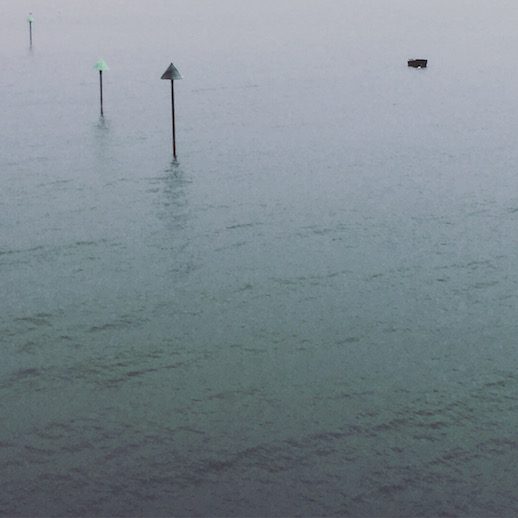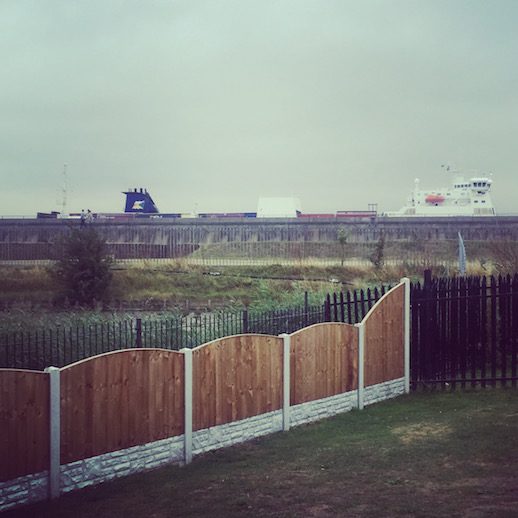Luke Turner samples some of the delights on offer at Estuary Festival ’16:
From the cocoon of transport the landscape of the Thames Estuary appears in two dimensions. I recently flew down the twin narrowing shorelines on a flight from Germany. As it descended into Gatwick, mudflats and industrial sites sank into the late summer sun below. Southend Pier was a pin stuck out into the grey brown blue water, in which the wakes of ships had made small white tears. Driving along the A13 towards the Estuary Festival a couple of weeks later, everything still existed in two planes, the flatness of the earth punctuated by power station chimneys and pylons, floodgates, piledrivers, the giant cranes of the docks at Tilbury and new super port a little further east. What at first looked like a gently rising hill turned out to be a landfill site, crawled by trucks.
Yet this is not the way to look at the Thames Estuary, for it’s in the macro that it reveals itself as one of the most compelling landscapes in the south of England. It’s not a picturesque place, but it is easily fetishised, for the dereliction, the alien flight of giant ships, the incongruity of horses grazing on a narrow patch of grass by a road along which container trucks thunder from Tilbury docks, all night and every 30 seconds or so. The blackberries there were full and juicy, on bushes flying banners of plastic. I started shoving them into my gob before noticing the slightly sour tint of hydrocarbons.
Metal, the organisers of the Estuary Festival, have occupied various locations along the Thames shoreline for this year’s festival. In a series of beach huts on the landward end of Southend Pier are various exhibits relating to the area – one reflecting last weekend’s excellent Radical Essex exhibition, curated by the Focal Point Gallery and devoted to the outsiders who made the county their own. There’s a showing of Nick Abrahams and Jeremy Deller’s The Posters Came From The Walls, their wonderful and hard-to-find film about Depeche Mode fans. Another hut is lined with Billy Childish’s prints of monochrome and water, the Chatham sky captured on paper. Further inland a shipping container painted with semaphore flags has been plonked on a grassy bank between the coast road and the houses, not far from a billboard for Sugar Hut – It’s Not Just A Nightclub It’s A Lifestyle. This steel box, cousin of the thousands that come in and out of the Thames every day, is on the site of what will hopefully become the home of a new museum of the Thames Estuary. Inside, one wall is covered by a map of aircraft and shipwrecks scooped up from the estuary, fragments of which (a paddle steamer, a Junkers 88 reconnaissance aircraft) are in museum vitrines. But how can you define or record such an ever-changing, elusive place?
The main Estuary Festival location is at the Tilbury Cruise Terminal, a few miles inland from Southend. There’s a large hall that once connected to the railway line from London, now torn up and replaced by the container road. Giant hinged arms and gangways link the shore to the huge pontoon where thousands boarded ships to new lives in the former colonies, and where thousands more arrived in Britain – it was here that the Windrush landed in 1948. Most of the artworks are presented in the old port offices on the pontoon, where buckets catch leaks from the ceiling in the foreman’s changing rooms and Havengore’s Store. The whole structure rises and falls with the tide and occasionally shudders from the wakes of passing container ships.
It is, needless to say, an impressive venue. Much of the work here is excellent, too. Especially good are Chloe Dewe Mathews’ photographs of Thameside rituals, which might equally be commuting over London bridge or reading the paper on the foreshore as a scattering of the ashes from Southend Pier or Indian funeral. This exploration of the human instinct to define ourselves against water also resonates in Louisa Fairclough’s The Incidental Musicality Of A Chance Encounter. The audience is invited to put on headphones and listen to a record of a generative musical instrument being played by the wind and tide, the thick sound of wind and microphone, a drone like a dry throated hurdy-gurdy, and the sound of boys mucking around on a Canvey Island jetty. “The water’s going aaht” someone says; another sings Destiny’s Child’s Say My Name. As with Mathew’s photography there is a subtle capturing of people, time and place. Yet some of the other work too quickly falls into the 2D cliché of the flatness of the landscape, with more than one video piece featuring figures dancing, writhing or walking across an endless mud, marsh or sea horizon.
This sense of people parachuted in without connecting reflects a strange unease I have throughout the weekend. There’s a lot of being shouted at and ushered around, go to this, don’t go there, if you light a cig it’s two hundred quid, even outside. This is an isolated spot, separated from Tilbury town by the container port and the scrubland, and I feel uncomfortable coming out here to marvel at all this art and all these words about the oozing darkness etc, and then returning upriver to London. There’s a lot of talk of “placemaking”, as if the estuary and its towns didn’t have much to offer before the arts arrived. Do we want everywhere to end up like Margate? Do we really want the south east of England surrounded by smarted-up islands, Hackneys-on-Sea? I can see a future where those who got on the property ladder in booming London remortgage to buy second homes around the coast, and demand all the cultural amenities they were accustomed to back in the capital without more than a cursory thought for the needs of those they’re living amongst. These are already divided communities, cut off from the wealth of the city upstream, and should not be made more so in the name of redevelopment through art.
This quibble, however, shouldn’t detract from the impact of much of the best work at Estuary. In the old circulating hall of the port’s train station a giant screen shows a stunning film by John Akomfrah Mnemosyne, an artist whose practice explores issues of identity, race and immigration. Where once crowds of people would have swirled past passport control towards trains to London, Mnemosyne’s film is a vivid and sumptuous collage. Film of a figure in a yellow jacket, walking through a wintry mountainous landscape, anchors archive footage of immigrant communities in the UK, racist graffiti and abstract shots of a black man on a building site in what looks like Liverpool, around which are interspersed readings from literature – from John Berger to E E Cummings and Paradise Lost. Mnemosyne captures a real sense of displacement: exactly what’s missing with the muddy ballerinas elsewhere.
Patrick Wright, arguably our greatest writer on place, does the same in a superlative talk on the wreck of the USS Montgomery. Of course, this being Wright, it isn’t just a talk about the bomb laden wreck of the American Liberty Ship that lies on an estuary sandbank, but a clear narrative that links it to the German writer Uwe Johnson who wound up in the town of Sheerness during the 1970s. Johnson, Wright tells us, explored the parallels between different places in his work – how a view over one sea might be mirrored elsewhere on the planet. He points out just how similar the Thames Estuary is in shape to the Bay of Lubeck, where Johnson was born, and surmises that this would not have been lost on the writer. Did he connect the wreck of the Montgomery, sat there with the potential to explode in one of the biggest non-nuclear explosions in history, with another wartime tragedy that happened in the waters off Lubeck? Death lies beneath a placid surface, or just ashore. Johnson died in Sheerness drunk and dissolute in 1984 and at his funeral he requested that there be no music, speeches flowers or any religious service. Says Wright: “Memory is a death wish, a torment, a horror”. It’s a pleasing counter to the offer of a ‘retro’ bus trip to Southend.
Every 20 minutes or so, a small Thames working boat leaves the back of the pontoon for French & Mottershead’s audio piece, Waterbourne. The engine rattles an open deck streaked by rust as it powers across the river to moor to a line running from a derelict jetty, onto which someone has painted in white letters WEST HAM UND. Everyone on board is given a set of headphones but no instructions, aside from being told to press play. Underwater recordings and the ‘real’ sound of the wind in the headset sit beneath the narrative of a dead body, washed down a canal and into the river out to sea. I stand swaying on the deck and trying to ignore the diesel fumes as a half-full litre of milk drifts past on the ebbing tide. The calm voice in the ears encourages us to imagine our own bodies decaying in the water. Whispered with the wind and the sound of the water into the intimacy of our ears, this is grimly visceral: all relaxed sphincter, the cells of the body digesting themselves, the relaxing of sweat glands into which water pours along with passenger microbes and bacteria. Yet… yet there’s something comforting, liberating, moving about it all too, for estuaries are the places of our coming and going, where the drowned body – which is, after all, 60% water – will dissolve and become part of the tide. Everyone is silent as the boat casts off and coughs into to life to sail us back to Tilbury. The Thames around us is a boiling, impenetrable earth brown that glitters with the infinite conjugations of the reflected sky, at once dense and foreboding, but glistening light.
*
Estuary Festival continues until 2 October.
Luke is the co-founder & editor of The Quietus. He is currently researching and writing a book on the unusual goings-on in – and people’s history of – Epping Forest.

